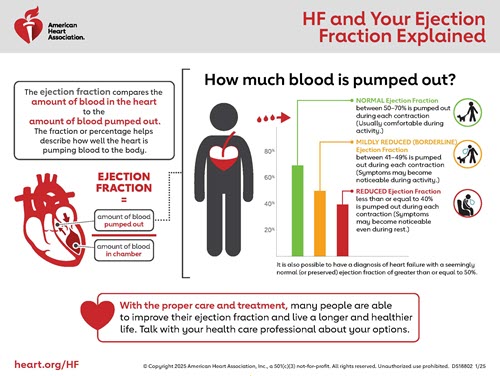Ejection Fraction Heart Failure Measurement
Video: La fracción de eyección del corazón
What is “ejection fraction”?
Ejection fraction (EF) is a measurement, expressed as a percentage, of how much blood the left ventricle pumps out with each contraction. An ejection fraction of 60 percent means that 60 percent of the total amount of blood in the left ventricle is pushed out with each heartbeat. A normal heart’s ejection fraction is between 55 and 70 percent.
This indication of how well your heart is pumping out blood can help to diagnose and track heart failure.
It is important to note, however, that you can have a normal ejection fraction measurement and still have heart failure. This is called HFpEF or heart failure with preserved ejection fraction. It happens when your heart’s muscle has become so thick and stiff that the ventricle holds a smaller than usual volume of blood. In this case, your heart might still have an ejection fraction that falls in the normal range because your heart is pumping out a normal percentage of the blood that enters it. However in HFpEF, the total amount of blood pumped isn’t enough to meet your body’s needs.
What’s an unhealthy EF?
An EF from 41 to 49 percent might be considered too low. It does not always indicate that a person is developing heart failure, but it could indicate damage, perhaps from a previous heart attack. An ejection fraction measurement under 40 percent might be evidence of heart failure or cardiomyopathy. In severe cases, EF can be even lower than 40.
Learn ways to improve your low ejection fraction.
An ejection fraction measurement higher than 75 percent could indicate a heart condition such as hypertrophic cardiomyopathy.

View HF And Your Ejection Fraction Explained English (PDF) | Spanish (PDF)
Using ejection fraction in diagnosis
Your health care professional might mention one of these two EF-related scenarios:
- Preserved ejection fraction (HFpEF) – also referred to as diastolic heart failure. The heart muscle contracts normally, but the ventricles do not relax as they should during ventricular filling (or when the ventricles relax).
- Reduced ejection fraction (HFrEF) – also referred to as systolic heart failure. The heart muscle does not contract effectively, and therefore less oxygen-rich blood is pumped out to the body.
Tests for measuring EF
Your health care professional might recommend one or more of these tests to measure your ejection fraction:
- Echocardiogram (or “echo”) - the most widely used test
- MUGA scan
- CT scan
- Cardiac catheterization
- Nuclear stress test
Learn more about common tests for diagnosing heart failure.






